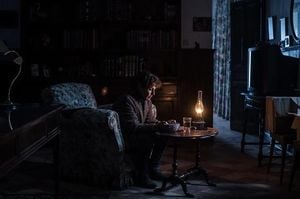The third season of HBO's The White Lotus opens with captivating images of monkeys, setting the tone for the series as it immerses viewers once again in the complex dynamics of wealth and privilege, intersected with raw emotional struggles. Notably, the symbolic importance of monkeys emerges early on, shaping the narrative through their frequent appearances, as both live animals and shadowy figures, throughout the premiere episode.
Creator Mike White emphasizes the thematic depth behind the choice of this prominent symbolism, stating, "My personal feeling is we're animals and this season, particularly, is about people trying to reach their spirituality at this animalistic base." This stark juxtaposition between the innate primate instincts and the higher aspirations of spirituality resonates deeply through each scene.
This season, set within the picturesque backdrop of Thailand, follows various emotionally-stunted wealthy guests assembled at the fictional White Lotus resort. These guests engage superficially with practices like meditation and mindfulness, aiming for self-improvement and clarity but often failing to escape their personal 'monkeys'. These metaphorical monkeys represent the distractions, insecurities, and primal urges each character grapples with.
Right from the start, the opening scene features Belinda’s son, Zion, receiving guided meditation—only to be distracted by monkeys swinging through the nearest trees. When guided by his wellness concierge, Amrita, to “calm our chattering monkey minds,” it becomes evident how the show is not merely entertaining but dives deep by linking the playful imagery of monkeys to the serious struggles of the characters, echoing the Buddhist teaching about mental distraction.
Each character's narrative arc reflects personal conflicts marked by insecurities and the competition for validation. For example, childhood friends Jaclyn, Kate, and Laurie reunite at the resort, where long-standing tensions rise to the surface. Jaclyn, played by Michelle Monaghan, is established as the successful TV actress funding the trip, whereas Laurie (Carrie Coon) feels the weight of unspoken jealousy, often complicities rooted deep from their school years. Their interactions are punctuated by backhanded compliments and passive aggression, evoking the child-like jealousy often associated with monkey behavior.
Walton Goggins portrays Rick, whose flirtation with volatile emotions and distaste for his surroundings mirrors the unpredictable nature of the monkeys themselves. His relationship with younger girlfriend Chelsea (Aimee Lou Wood) is fraught with miscommunication, akin to how monkeys can swing from companionable to confrontational at the drop of a hat.
Significantly, the resort setting is also woven with natural beauty juxtaposed against the guests' chaotic mental states. While they inhabit this serene environment—complete with lush landscapes and tranquil resorts—the guests are caught up in their dramas. The earlier mentioned ‘monkey mind’ becomes more than just individual thoughts, symbolizing the attendees’ inability to engage with what surrounds them due to internal chaos.
“Just don’t feed them,” Kate cautions Laurie when they spot monkeys on their balcony reacting mischievously. This statement reinforces caution not just toward these primal creatures but also serves as advice for managing their own emotional monkeys—both within and around them. The monkeys continue to serve as reminders of their unfinished personal business they cannot escape even amid luxury.
Despite the tranquil environment, underlying tensions hint at greater conflicts set to unravel over the season, set against the eerie opening scene of a body floating, foreshadowing the chaos to come. It encapsulates the show's tendency to maintain tension, reminiscent of the duality found within the monkey symbolism themselves: capable of engaging playfulness but also violent unpredictability.
One of season three’s pivotal scenes occurs when the resort staff conducts wellness sessions aiming to guide guests toward enlightenment. Yet, the specter of the charismatic yet existential theme looms as the show cleverly utilizes the chameleonic nature of the monkeys, acting as echo chambers reflecting the characters’ own impulsivity and moral vacuums.
Overall, as The White Lotus progresses, the season’s plot appears to dissect not only individual insecurities but also collective identities connected through socioeconomic privilege, self-deception, and the frivolity of human experiences, all captured vividly through the monkey motif. The juxtaposed nature of guests facing their inner turmoil amid the peaceful façade of Thailand reminds viewers of the thin line separating humanity from its primal roots, which is writ large on the script through astute observation.
The monkey—always watching, questioning, reflecting—becomes the audience's silent guide through humanity's chaotic entanglements, posing the ever-persistent question: can one truly evolve beyond their foundational instincts? The recurring symbolism throughout the third season of The White Lotus sets expectations high as themes of spirituality and humanization contend with the darker patterns of behavior.
Indeed, as Mike White continues to blend humor with stark realism, viewers are reminded of the constant battle between aspiration and animal instinct. Season three promises to test not only the characters but also audience perceptions of luxury, leisure, and the layered truths hiding within.



